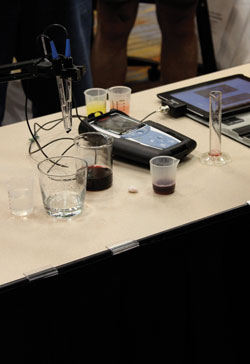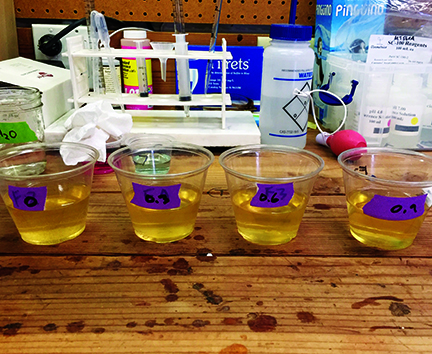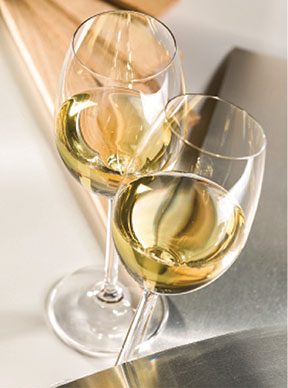From a structural perspective, acidity is the most important part of white wines, and in reds, a close second after phenolics. Acidity is what gives wines vibrancy and liveliness. It is a major factor in protecting wines from spoilage. Acidity is also a complex aspect of wine and wine chemistry, and a dynamic one for wine tasting.
There are two major acids in grapes: Tartaric and malic. Tartaric acid is rare in the fruit world, and as far as common fruits in North America go, is essentially only found in significant quantities in grapes. Sumac, a Middle Eastern spice, and tamarinds are two other fruits that contain tartaric, and there is a bit in bananas and citrus as well. It may be because of this rarity that it is something of an untouchable — whereas there are many bacteria that can feed on more common malic and citric acids — and in winemaking we take steps to convert or protect our pool of malic acid. Tartaric acid is safe, and we need not worry about it getting consumed by microorganisms.
Malic acid is much more common in the fruit world. It is the primary acid in apples (think Granny Smith), as well as most stone fruits and berries. Whereas tartaric acid in wine does not change its form, malic acid can go one of two ways: It can remain as malic acid, or it can be partially or entirely converted to the less intense lactic acid.
HOW ACID BEHAVES IN GRAPES
Acids accumulate in grapes prior to veraison. If you’ve ever tasted a grape that has not begun veraison, between the intense acid and tannins, it’s likely not an experience you’ll forget! During ripening, malic acid is metabolized (more accurately, respired), little by little, while tartaric acid remains relatively stable, as far as the amount in each grape (the proportion changes relative to water, sugar, and other constituents, as the grapes swell during veraison). Warmer weather speeds up malic metabolism, and regardless of weather, the longer a grape remains on the vine, the less malic acid it will have.
HOW ACID BEHAVES IN WINE
Acids are molecules that, in certain environments, like water, will release a hydrogen ion (a single proton). There are two measurements of acidity used to understand a wine’s acidity: Titratable acidity (TA) and pH. The book Winegrape Berry Sensory Assessment in Australia provides a great description of each: “Titratable acidity in grape juice measures all the hydrogen ions, encompassing those that are free in solution and those bound to acids and acid-salts, such as potassium bitartrate and dipotassium tartrate . . . pH relates to the concentration of the free hydrogen ions in the grape juice . . . the hydrogen ions come from the disassociation of wine acids in water.”
For TA, a higher number means more acid. For pH, which is measured on a logarithmic scale, a continuum of acid to base, the lower the number, the greater the amount of free hydrogen ions in the wine, and therefore the more intense the perception of acid is in a wine. Wine pH normally ranges from the low to high 3s.
TASTING ACID IN WINE
Acidity is detected in our mouths via a protein found on our tongues. In essence, these proteins act as pH meters for our oral senses — the more intense and sharper the acidic sensation, generally the lower the wine’s pH. Wines with especially high TA usually create a sensation toward the back of the mouth and salivation under the tongue, but these are not actually “tastes,” which can only come from taste buds, they are sensations. Especially high TA wines (10 g/L +) can lead to heartburn, especially if not consumed with food.
Temperature also affects the perception of acidity: Higher temperatures diminish acid perception, while lower temperatures increase it.
Other factors will affect how acidic a wine tastes. The presence of sweetness and salinity will decrease the perception of acidity, while the presence of acidity will increase the perception of both sweetness and salinity. Temperature also affects the perception of acidity: Higher temperatures diminish acid perception, while lower temperatures increase it.
For these reasons, it’s important to measure acidity (and sugar) when sampling your fruit in the vineyard. For example, a warm berry on a hot day will seem much less acidic than it would have while it was cool earlier that morning — the acidity in the berry has likely changed very little in that time, it is simply how our tongues and brains interpret the taste.
STYLE CONSIDERATIONS
White wines generally have lower pH levels than red, often below 3.4. These not only assist in protecting white wines from microbial attack (the lower the pH, the less types of microbes that can survive there), but is what gives them their crispness (makes them refreshing) — this is why lemonade on a hot day seems so much more appealing than a simple glass of water. It keeps wines vibrant, fresh, and lively in the mouth and easy to drink. White wines with a higher pH (think ripe California Chardonnay) can often be heavy and sort of sit in the mouth. These types of whites often do not age as well as similar grapes with a lower pH.

Reds are typically above 3.5, and the conversation about acid in reds is a little more complicated and controversial. Acidity leads to an increase in the perception of astringency from tannins, so more tannic wines often have higher pH’s (3.6+) than lower tannin wines, which are often made in a fresher, lower pH style. More tannic reds are usually driven by mouthfeel and tannin structure, where as less tannic wines are usually driven by freshness and acidity. Both tannins and acidity help wines age, so in lower tannin reds (as well as whites, which lack a phenolic structure), having acidity when you don’t have tannins will add to longevity.
Some sparkling wines will be a bit below 3, and some winemakers choose to bottle their wines above 3.9, although this is very risky, leaving wines especially susceptible to microbial attack.
WINEMAKING CONSIDERATIONS
Once you’ve decided the style of wine you’d like to make, remember that the numbers for your acidity will shift during the winemaking process. Malolactic fermentation (MLF) will lower your TA and raise your pH. Usually the shift in pH is about 0.2, however, as malic acid levels change, and as every wine’s chemistry is unique, this is only an estimate. With especially ripe grapes or cool, slow ripening vintages, more malic acid may have metabolized, leading to a smaller shift.
Stem inclusion in fermentation will also absorb and lower acidity. Drought years can lead to higher potassium levels in grapes, which can lead to an increase in pH, relative to TA. Potassium is one of the major acid binders that result in the difference between TA and pH, and is at a unique level for every wine. When cold stabilizing, your TA will decrease, but, if your pH is below 3.6, this reduction in TA will result in a lowering of your pH. If your pH is above 3.6, it will result in an increase in pH.
Lower pH also results in SO2 being more effective in protecting the wine. SO2 changes into various forms once added to wine, and only a small percent will be in its molecular form, which offers the majority of microbial protection. The lower the pH of a wine, the larger the proportion will be of molecular SO2. Therefore, the lower the pH, the less SO2 is needed to achieve microbial protection (to arrive at the desired level of molecular SO2 in your wine).
INCREASING ACID
The rule of thumb for acid additions, which is almost always done with tartaric acid, is 1 g/L to lower pH by 0.1, however, wine chemistry being as complex as it is, this is not always the case, and you can end up with a smaller or larger change than you expect (or want). The other rule of thumb is to acidify as little as possible and to do so in smaller increments.
Add the minimum amount of acid necessary to achieve your goal, as an overly large acid addition can eventually affect taste negatively (can give a hard sensation or an aspirin-y taste, as well as leave tartrates in the glass or bottle). Acidity is one of the major reasons matching variety to site is so important: Not only is it less work to make a wine when the grapes consistently ripen with desirable acidity levels, but when there is a big discrepancy, it can lower quality. It is ideal to add small doses of acid over time, testing as you go along (aim for a pH change of 0.02–0.04). This way you minimize your risk of a large jump — it is better to add a little more acid later than to end up with an overly acidic wine, or the need to deacidify!
As it is ideal to make small additions and test pH as you proceed, it is unfortunate to learn that acid is also best added before or during fermentation, when it will integrate better into the wine, and you will be at less of a risk for the telltale acidified taste, or tartrates in bottle or your wine glass. It would be best to make your first addition before or during fermentation, and make smaller adjustments, if needed, after fermentation. When doing this, anticipate how your acid level will change, especially with respect to MLF.
When lowering pH, it is important to be aware of TA. Usually, wines needing additions to lower pH will have a low enough TA that acid additions can safely be made without knocking the TA levels out of balance (say, less than 7.5 g/L in red wines . . . above that would be high). However, and usually resulting in high potassium in the grapes, a high TA and high pH wine can happen — it may be rare, but it is possible. This is a much more complicated situation, and there are various routes that can be taken, which is a subject onto its own.
DEACIDIFYING
Before we get into deacidification, a thought on style. Overall, higher acid red wines are not a bad thing. Although the red wines that garner the most attention from critics often have pH’s above 3.7 (along with firm, tannic structures and lots of baby fat), wine trends are shifting toward fresher, leaner, lower pH reds. Often these wines are less tannic and extracted, and favor elegance over power. I often see hybrid winemakers concerned about their reds, which have intense acidity, and most of the time I don’t see what the concern is about. Although personal preference should guide winemaking choices above all else, if working with fairly low-pH/high-TA red grapes, consider making a lighter, fresher style of wine (low extraction during fermentation with neutral barrels, concrete, or stainless). Your site and grapes may be better suited to create such wines, rather than the big, full, lower-acid (higher-pH) styles many are accustomed to as a result of fluctuating trends resulting from marketing, critic bias, and random historic circumstance. Acidity in wine also means more food friendliness and often better drinkability.
That being the case, a wine, red or white, with a pH at or below three and a TA above 12 may be difficult to drink, or, simply not what you’re interested in making. For that type of scenario, there are various options for deacidification.
I spoke with WineMaker contributor Dominick Profaci, who grows and makes many hybrid grapes in the Hudson Valley in New York, about working with extreme high-acid wines. He often sees high levels of acidity with his Frontenac and Marquette.
Although personal preference should guide winemaking choices above all else, if working with fairly low-pH/high-TA red grapes, consider making a lighter, fresher style of wine.
Although the use of potassium bicarbonate and calcium carbonate salts are common for deacidification, and may be a good way to go for minor corrections, Dominick avoids them for the extreme cases we’re talking about: “I am personally not a fan of adding salts, as these impact flavor and aroma at the levels that are needed. I blend (high-acid) grapes with other lower acid varieties, some that I grow, and others from California. Many ferment with yeast strains that lower acidity (like Lalvin 71B), put the wine through MLF (with a strain that can work at the lower pH), and cold stabilize to drop out the tartaric acid (yes, cold stabilize a red!), and, if the wine is still too tart, I may cellar blend the wine with a more flabby wine to make a blend that is better than its parts.”
So as you can see, acid is a dynamic part of wine. One especially pleasant aspect of acid, relative to other such important aspects of wine like phenolics for example, is that we have a pretty clear picture of all that’s going on with it. Proper site/variety pairing is always the best way to ensure you get fruit with balanced chemistry, and the fruit that you have to tweak the least (or ideally not at all) is usually what will make the best tasting wine. However, there are many options for increasing acidity, either to make up for less than ideal chemistry, or to make a wine that’s more in line with what you like to drink.
SOURCES:
Winegrape Berry Sensory Analysis in Australia. Winter, Whiting, and Rousseau, 2009. Winetitles, Department of Primary Industries, Victoria, Australia.







